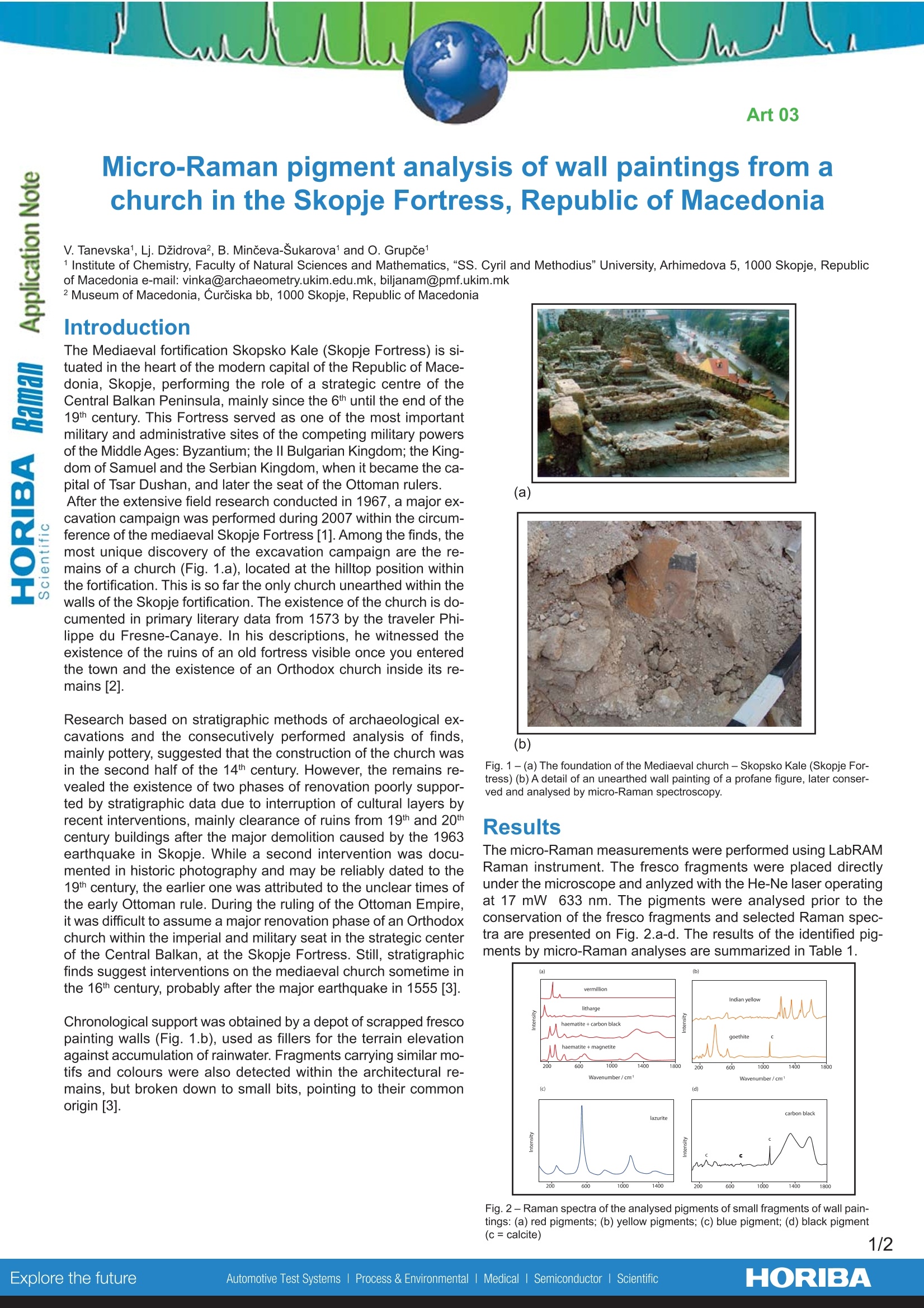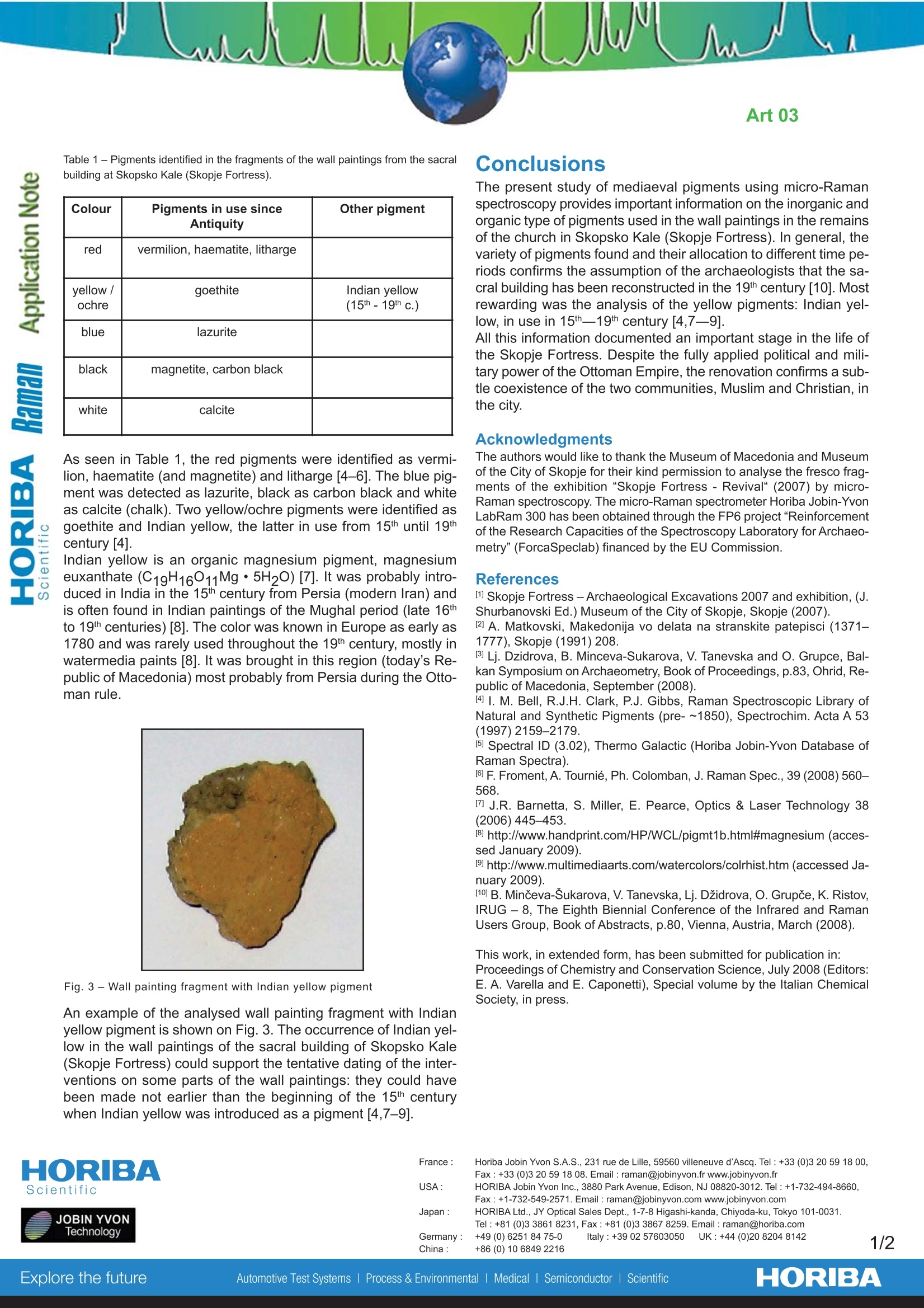方案详情
文
The present study of mediaeval pigments using micro-Raman spectroscopy provides important information on the inorganic and organic type of pigments used in the wall paintings in the remains of the church in Skopsko Kale (Skopje Fortress). In general, the variety of pigments found and their allocation to different time periods confirms the assumption of the archaeologists that the sacral building has been reconstructed in the 19th century. Most
rewarding was the analysis of the yellow pigments: Indian yellow, in use in 15th―19th century.
All this information documented an important stage in the life of the Skopje Fortress. Despite the fully applied political and military power of the Ottoman Empire, the renovation confirms a subtle coexistence of the two communities, Muslim and Christian, in the city.
方案详情

Art 03 Micro-Raman pigment analysis of wall paintings from achurch in the Skopje Fortress, Republic of Macedonia V. Tanevska1, Lj. Dzidrova, B. Minceva-Sukarova1 and O. Grupce1 1 Institute of Chemistry, Faculty of Natural Sciences and Mathematics,“SS. Cyril and Methodius” University, Arhimedova 5, 1000 Skopje, Republicof Macedonia e-mail: vinka@archaeometry.ukim.edu.mk, biljanam@pmf.ukim.mk Introduction The Mediaeval fortification Skopsko Kale (Skopje Fortress) is si-tuated in the heart of the modern capital of the Republic of Mace-donia, Skopje, performing the role of a strategic centre of theCentral Balkan Peninsula, mainly since the 6h until the end of the19th century. This Fortress served as one of the most importantmilitary and administrative sites of the competing military powersof the Middle Ages: Byzantium; the II Bulgarian Kingdom; the King-dom of Samuel and the Serbian Kingdom, when it became the ca-pital of Tsar Dushan, and later the seat of the Ottoman rulers. After the extensive field research conducted in 1967, a major ex-cavation campaign was performed during 2007 within the circum-ference of the mediaeval Skopje Fortress [1].Among the finds, themost unique discovery of the excavation campaign are the re-mains of a church (Fig. 1.a), located at the hilltop position withinthe fortification. This is so far the only church unearthed within thewalls of the Skopje fortification. The existence of the church is do-cumented in primary literary data from 1573 by the traveler Phi-lippe du Fresne-Canaye. In his descriptions, he witnessed theexistence of the ruins of an old fortress visible once you enteredthe town and the existence of an Orthodox church inside its re-mains [2]. Research based on stratigraphic methods of archaeological ex-cavations and the consecutively performed analysis of finds,mainly pottery, suggested that the construction of the church wasin the second half of the 14h century. However, the remains re-vealed the existence of two phases of renovation poorly suppor-ted by stratigraphic data due to interruption of cultural layers byrecent interventions, mainly clearance of ruins from 19th and 20hcentury buildings after the major demolition caused by the 1963earthquake in Skopje. While a second intervention was docu-mented in historic photography and may be reliably dated to the19thcentury, the earlier one was attributed to the unclear times oftheearly Ottoman rule. During the ruling of the Ottoman Empire,it was difficult to assume a major renovation phase of an Orthodoxchurch within the imperial and military seat in the strategic centerof the Central Balkan, at the Skopje Fortress. Still, stratigraphicfinds suggest interventions on the mediaeval church sometime inthe 16h century, probably after the major earthquake in 1555 [3]. Chronological support was obtained by a depot of scrapped frescopainting walls (Fig. 1.b), used as fillers for the terrain elevationagainst accumulation of rainwater. Fragments carrying similar mo-tifs and colours were also detected within the architectural re-mains, but broken down to small bits, pointing to their commonorigin [3]. (a) (b) Fig. 1-(a) The foundation of the Mediaeval church -Skopsko Kale (Skopje For-tress) (b) A detail of an unearthed wall painting of a profane figure, later conser-ved and analysed by micro-Raman spectroscopy. Results The micro-Raman measurements were performed using LabRAMRaman instrument. The fresco fragments were placed directlyunder the microscope and anlyzed with the He-Ne laser operatingat 17 mW 633 nm. The pigments were analysed prior to theconservation of the fresco fragments and selected Raman spec-tra are presented on Fig. 2.a-d. The results of the identified pig-ments by micro-Raman analyses are summarized in Table 1. Colour Pigments in use sinceAntiquity Other pigment red vermilion, haematite, litharge yellow /ochre goethite Indian yellow(15th-19th c.) blue lazurite black magnetite, carbon black white calcite As seen in Table 1, the red pigments were identified as vermi-lion, haematite (and magnetite) and litharge [4-6]. The blue pig-ment was detected as lazurite, black as carbon black and whiteas calcite (chalk). Two yellow/ochre pigments were identified asgoethite and Indian yellow, the latter in use from 15h until 19thcentury [4]. Indian yellow is an organic magnesium pigment, magnesiumeuxanthate (C19H16911Mg·5H2O)[7]. It was probably intro-duced in India in the 15h century from Persia (modern Iran) andis often found in Indian paintings of the Mughal period (late 16hto 19th centuries) [8]. The color was known in Europe as early as1780 and was rarely used throughout the 19th century, mostly inwatermedia paints [8]. It was brought in this region (today's Re-public of Macedonia) most probably from Persia during the Otto-man rule. Fig. 3 - Wall painting fragment with Indian yellow pigment An example of the analysed wall painting fragment with Indianyellow pigment is shown on Fig. 3. The occurrence of Indian yel-low in the wall paintings of the sacral building of Skopsko Kale(Skopje Fortress) could support the tentative dating of the inter-ventions on some parts of the wall paintings: they could havebeen made not earlier than the beginning of the 15th centurywhen Indian yellow was introduced as a pigment [4,7-9]. USA Conclusions The present study of mediaeval pigments using micro-Ramanspectroscopy provides important information on the inorganic andorganic type of pigments used in the wall paintings in the remainsof the church in Skopsko Kale (Skopje Fortress). In general, thevariety of pigments found and their allocation to different time pe-riods confirms the assumption of the archaeologists that the sa-cral building has been reconstructed in the 19th century [10]. Mostrewarding was the analysis of the yellow pigments: Indian yel-low, in use in 15th-19th century [4,79]. All this information documented an important stage in the life ofthe Skopje Fortress. Despite the fully applied political and mili-tary power of the Ottoman Empire, the renovation confirms a sub-tle coexistence of the two communities, Muslim and Christian, inthe city. Acknowledgments The authors would like to thank the Museum of Macedonia and Museumof the City of Skopje for their kind permission to analyse the fresco frag-ments of the exhibition“Skopje Fortress - Revival“ (2007) by micro-Raman spectroscopy. The micro-Raman spectrometer Horiba Jobin-YvonLabRam 300 has been obtained through the FP6 project"Reinforcementof the Research Capacities of the Spectroscopy Laboratory for Archaeo-metry" (ForcaSpeclab)financed by the EU Commission. ( References ) ( M Skopje Fortress-Archaeological Excavations 2007 and exhibition, (J. S hurbanovski E d .) Museum of the City of Skopje, Skopje ( 2 007). ) ( [2 A. Matkovski, M akedonija vo de l ata na stranskite patepisci (1371- 1 777), Skopje (1991)208. ) 3Lj. Dzidrova, B. Minceva-Sukarova, V.Tanevska and O. Grupce, Bal-kan Symposium on Archaeometry, Book of Proceedings,p.83, Ohrid, Re-public of Macedonia, September(2008). 41.M. Bell, R.J.H.Clark, P.J. Gibbs, Raman Spectroscopic Library ofNatural and Synthetic Pigments (pre-~1850), Spectrochim. Acta A 53(1997)2159-2179. 5] Spectral ID (3.02), Thermo Galactic (Horiba Jobin-Yvon Database ofRaman Spectra). 6 F. Froment, A. Tournie, Ph. Colomban, J. Raman Spec.,39 (2008)560-568. J.R. Barnetta, S. Miller, E. Pearce, Optics & Laser Technology 38(2006)445-453. [8] http://www.handprint.com/HP/WCL/pigmt1b.html#magnesium (acces-sed January 2009). 19] http://www.multimediaarts.com/watercolors/colrhist.htm (accessed Ja-nuary 2009). [10] B. Minceva-Sukarova, V. Tanevska, Lj. Dzidrova, O. Grupce, K. Ristov,IRUG- 8, The Eighth Biennial Conference of the Infrared and RamanUsers Group, Book of Abstracts, p.80, Vienna, Austria, March (2008). This work, in extended form, has been submitted for publication in:Proceedings of Chemistry and Conservation Science, July 2008 (Editors:E. A. Varella and E. Caponetti), Special volume by the Italian ChemicalSociety, in press. ( France : H oriba Jobin Yvon S. A .S., 23 1 rue de Lille, 59 5 60 vil l e n euve d'Ascq. Tel : +33 (0)3 20 59 18 0 0 , F ax : +33 ( 0)3 20 59 1 8 08. Email : raman@jobinyvon.fr www.jo b inyvon.fr ) ( H O RIBA Jobin Yvon Inc., 3880 Park Avenue, Edison, N J 08820-3012. Tel: + 1 -732-494-8660 Fax: + 1-732-549-2571. Email: raman@jobinyvon.com www.jobinyvon.com Japan : H ORIBA Ltd., JY Optical Sales Dept., 1-7-8 H igashi-kanda, Chiyoda-ku, To kyo 101-0031. ) Tel:+81 (0)3 3861 8231,Fax:+81 (0)3 3867 8259. Email: raman@horiba.com ( Germany : +49 (0)6251 8475-0 Italy : +39 02 57603050 UK: + 44 (0)20 8204 8142 ) +86 (0)10 6849 2216 ORIBAExplore the futureAutomotive Test Systems Process & Environmental Medical ISemiconductorrlScientific The present study of mediaeval pigments using micro-Raman spectroscopy provides important information on the inorganic and organic type of pigments used in the wall paintings in the remains of the church in Skopsko Kale (Skopje Fortress). In general, the variety of pigments found and their allocation to different time periods confirms the assumption of the archaeologists that the sacral building has been reconstructed in the 19th century. Mostrewarding was the analysis of the yellow pigments: Indian yellow, in use in 15th―19th century.All this information documented an important stage in the life of the Skopje Fortress. Despite the fully applied political and military power of the Ottoman Empire, the renovation confirms a subtle coexistence of the two communities, Muslim and Christian, in the city.
确定


还剩1页未读,是否继续阅读?
HORIBA(中国)为您提供《壁画颜料中颜色,化学组成检测方案(激光拉曼光谱)》,该方案主要用于颜料中颜色,化学组成检测,参考标准--,《壁画颜料中颜色,化学组成检测方案(激光拉曼光谱)》用到的仪器有
相关方案
更多
该厂商其他方案
更多









